
Hibiscus rosa-sinensis, known colloquially as Chinese hibiscus, China rose, Hawaiian hibiscus, rose mallow and shoeblack plant, is a species of tropical hibiscus, a flowering plant in the Hibisceae tribe of the family Malvaceae. It is widely cultivated as an ornamental plant in the tropics and subtropics, but its native range is Vanuatu.

The longhorn beetles (Cerambycidae), also known as long-horned or longicorns, are a large family of beetles, with over 35,000 species described. Most species are characterized by extremely long antennae, which are often as long as or longer than the beetle's body. In various members of the family, however, the antennae are quite short and such species can be difficult to distinguish from related beetle families such as the Chrysomelidae. The scientific name of this beetle family goes back to a figure from Greek mythology: after an argument with nymphs, the shepherd Cerambus was transformed into a large beetle with horns.
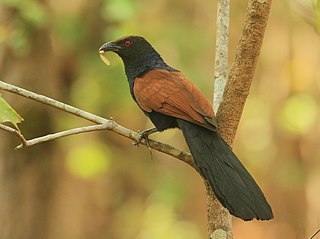
The greater coucal or crow pheasant, is a large non-parasitic member of the cuckoo order of birds, the Cuculiformes. A widespread resident in the Indian Subcontinent and Southeast Asia, it is divided into several subspecies, some being treated as full species. They are large, crow-like with a long tail and coppery brown wings and found in a wide range of habitats from jungle to cultivation and urban gardens. They are weak fliers, and are often seen clambering about in vegetation or walking on the ground as they forage for insects, eggs and nestlings of other birds. They have a familiar deep resonant call which is associated with omens in many parts of its range.

The citrus long-horned beetle is a long-horned beetle native to Japan, China, Korea, and Southeast Asia where it is considered a serious pest. Several countries in Europe had been infested with this insect in the past, including Italy, Switzerland, Turkey, France, Germany, and Croatia.

The Russian tortoise, also commonly known as the Afghan tortoise, the Central Asian tortoise, Horsfield's tortoise, four-clawed tortoise, and the (Russian) steppe tortoise, is a threatened species of tortoise in the family Testudinidae. The species is endemic to Central Asia. Human activities in its native habitat contribute to its threatened status.
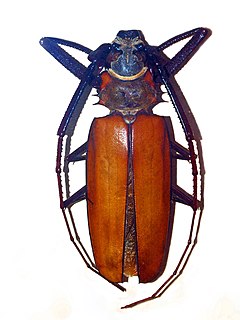
Enoplocerus is a genus of longhorn beetles in the subfamily Prioninae of the family Cerambycidae. It is monotypic, being represented by the single species Enoplocerus armillatus, commonly known as the giant longhorn beetle or imperious sawyer.
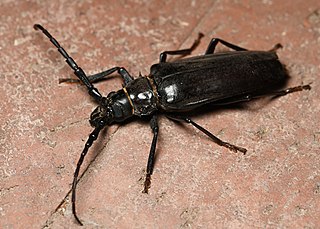
Derobrachus hovorei is a species of beetle in the family Cerambycidae, known variously as the palo verde beetle, palo verde root borer, or palo verde borer beetle. For over 100 years, this species was confused with the related species Derobrachus geminatus, and only recognized and given its own name by Santos-Silva in 2007; essentially all literature prior to 2007 therefore incorrectly uses the name geminatus for this species. It is a longhorn beetle native to the southwestern United States and northern Mexico which derives its common name from the palo verde tree, and it is one of the largest beetles in North America, reaching up to three and a half inches in length. Adults are black or brown in colour, have long antennae, and spines on the thorax. They have wings and can fly, albeit awkwardly at times. Mature beetles emerge in the summer to mate. Adults do not eat, and rely solely on their energy reserves until they die in about one month. While not harmful to humans, they can bite in self-defense.

Taenaris horsfieldii, the big eyed jungle lady or silky owl, is a butterfly of the family Nymphalidae.
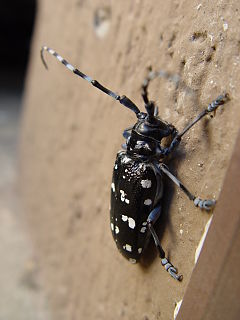
Anoplophora is a genus of beetles in the longhorn beetle family (Cerambycidae). They are native to Asia. Most are large and colorful and thus are depicted in artwork and sought after by beetle collectors. The genus also includes several notorious pest insects.

Anoplophora sollii is a species of beetles in the longhorn beetle family (Cerambycidae).
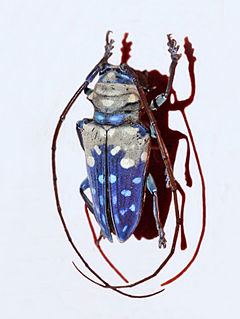
Sternotomis variabilis, the Lesser Jewel Longhorn Beetle, is a species of flat-faced longhorn beetles belonging to the family Cerambycidae.

Sternotomis itzingeri is a species of flat-faced longhorn beetles belonging to the family Cerambycidae.

Zographus oculator, the Orange-eyed Long-horn Beetle, is a species of flat-faced longhorn beetles belonging to the family Cerambycidae.
Pterolophia sinensis is a species of beetle in the family Cerambycidae. It was described by Léon Fairmaire in 1900.

Glenea apicalis is a species of beetle in the family Cerambycidae. It was described by Chevrolat in 1857, originally under the genus Saperda. It has a wide distribution in Africa. It feeds on Hibiscus rosa-sinensis.

Anoplophora beryllina is a species of beetle in the family Cerambycidae. It is distributed in China, Myanmar, India, Laos, and Vietnam.

Anoplophora elegans is a species of beetles in the longhorn beetle family (Cerambycidae). It was found by Gahan in the Mine District in Upper Burma (Myanmar). It is distributed in South East Asia.
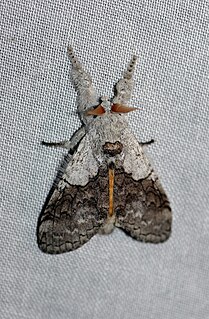
Calliteara horsfieldii, or Horsfield's tussock moth, is a moth of the family Erebidae. The species was first described by the British entomologist Edward Saunders in 1851, and named in honor of the British naturalist Thomas Horsfield, who traveled southern Asia and published works on zoology from the region. C. horsfieldii can be found in southern Asia, the islands of the northern Indian Ocean, and many parts of south east Asia and Indonesia. It is also sometimes referred to as the Yellow Tussock Moth.

Anoplophora medenbachii is a species of beetles in the family Cerambycidae. It is distributed in Southeast Asia.


















